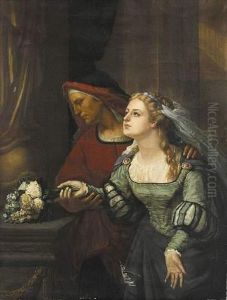Alfred Guillard Paintings
Alfred Guillard was a French artist known for his contributions to 19th-century European art, particularly in the realm of portrait painting and historical scenes. Born on June 16, 1827, in Paris, France, Guillard grew up during a period of significant social and political change, which influenced much of his work. Despite the relatively brief span of his life and career, he managed to leave a mark on the French art scene of his time.
Guillard's education in art began at a young age under the guidance of prominent artists of the period. He honed his skills at the prestigious École des Beaux-Arts in Paris, which was a breeding ground for many of the era's most significant artists. His style was primarily influenced by the Romantic movement, which was characterized by a focus on emotion, nature, and a fascination with the historical and exotic. However, he also incorporated elements of Realism, a burgeoning movement that emphasized the depiction of everyday life and society with truth and accuracy.
Throughout his career, Guillard showcased his work in various exhibitions, most notably at the Paris Salon, an annual art event that was the most esteemed in the Western world at the time. His portraits and historical paintings were well-received, praised for their detailed realism, sensitivity to light, and emotional depth. Guillard's ability to capture the essence of his subjects and to imbue his historical scenes with a sense of immediacy and drama garnered him a respectable following.
Despite his growing reputation, Guillard's life was cut short when he died on July 4, 1860, at the age of 33. The cause of his death remains less documented, but his passing was a loss to the French art community, which had seen in him a rising talent. Today, Alfred Guillard's works are housed in various galleries and private collections, admired for their technical skill and emotional resonance. Although his career was brief, his contributions to the development of French painting in the mid-19th century continue to be recognized by art historians and enthusiasts alike.


